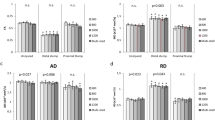Abstract
Objective
Piriformis muscle syndrome (PMS) is underdiagnosed. To evaluate the potential of diffusion tensor imaging and diffusion tensor tractography as innovative tools for the diagnosis of PMS by functional assessment of the sciatic nerve, the aims of this study are to assess the reproducibility and to evaluate the changes in the parameters at levels proximal and distal to the piriformis.
Materials and methods
Fractional anisotropy (FA) and the apparent diffusion coefficient (ADC) of the sciatic nerve at three levels were quantified twice each by two examiners using the fiber-tracking method. In the first part of the study, laterality and reproducibility were evaluated using intraclass correlation coefficients (ICC) in ten healthy volunteers. In the second part of the study, the healthy side and symptomatic side were assessed in ten consecutive patients with sciatica. There were three patients with no findings on lumbar magnetic resonance imaging (MRI).
Results
There was no laterality in either FA or ADC values in asymptomatic patients at any level. The mean intra-rater ICC was 0.90 and the mean inter-rater ICC was 0.87. FA was significantly lower and ADC significantly higher on the symptomatic side at each level in patients with sciatica. In the three sciatica patients with no findings on lumbar MRI, FA was significantly lower and ADC was significantly higher only at levels distal to the piriformis. These patients experienced full pain relief after ultrasound-guided injection of local anesthesia.
Conclusions
Diffusion tensor imaging and diffusion tensor tractography might be innovative tools for the diagnosis of PMS.






Similar content being viewed by others
References
Jankovic D, Peng P, van Zundert A. Brief review: piriformis syndrome: etiology, diagnosis, and management. Can J Anaesth. 2013;60:1003–12. doi:10.1007/s12630-013-0009-5.
Hopayian K. The clinical features of the piriformis syndrome. Surg Radiol Anat. 2012;34:671. doi:10.1007/s00276-012-0978-z.
Fishman LM, Dombi GW, Michaelsen C, et al. Piriformis syndrome: diagnosis, treatment, and outcome—a 10-year study. Arch Phys Med Rehabil. 2002;83:295–301. doi:10.1053/apmr.2002.30622.
Michel F, Decavel P, Toussirot E, et al. Piriformis muscle syndrome: diagnostic criteria and treatment of a monocentric series of 250 patients. Ann Phys Rehabil Med. 2013;56:371–83. doi:10.1016/j.rehab.2013.04.003.
Lewis AM, Layzer R, Engstrom JW, et al. Magnetic resonance neurography in extraspinal sciatica. Arch Neurol. 2006;63:1469–72. doi:10.1001/archneur.63.10.1469.
Yang HE, Park JH, Kim S. Usefulness of magnetic resonance neurography for diagnosis of piriformis muscle syndrome and verification of the effect after botulinum toxin type A injection. Medicine (Baltimore). 2015;94:e1504. doi:10.1097/MD.0000000000001504.
Filler AG, Maravilla KR, Tsuruda JS. MR neurography and muscle MR imaging for image diagnosis of disorders affecting the peripheral nerves and musculature. Neurol Clin. 2004;22(643–82):vi–vii. doi:10.1016/j.ncl.2004.03.005.
Howe FA, Filler AG, Bell BA, Griffiths JR. Magnetic resonance neurography. Magn Reson Med. 1992;28:328–38.
Basser PJ, Mattiello J, LeBihan D. MR diffusion tensor spectroscopy and imaging. Biophys J. 1994;66:259–67. doi:10.1016/S0006-3495(94)80775-1.
Kabakci N, Gürses B, Firat Z, et al. Diffusion tensor imaging and tractography of median nerve: normative diffusion values. Am J Roentgenol. 2007;189:923–7. doi:10.2214/AJR.07.2423.
Balbi V, Budzik JF, Duhamel A, et al. Tractography of lumbar nerve roots: initial results. Eur Radiol. 2011;21:1153–9. doi:10.1007/s00330-010-2049-3.
Takagi T, Nakamura M, Yamada M, et al. Visualization of peripheral nerve degeneration and regeneration: monitoring with diffusion tensor tractography. Neuroimage. 2009;44:884–92. doi:10.1016/j.neuroimage.2008.09.022.
Smith J, Hurdle MF, Locketz AJ, Wisniewski SJ. Ultrasound-guided piriformis injection: technique description and verification. Arch Phys Med Rehabil. 2006;87:1664–7. doi:10.1016/j.apmr.2006.08.337.
Miyagi R, Sakai T, Yamabe E, Yoshioka H. Consecutive assessment of FA and ADC values of normal lumbar nerve roots from the junction of the dura mater. BMC Musculoskelet Disord. 2015;16:156. doi:10.1186/s12891-015-0576-4.
Mori S, Zhang J. Principles of diffusion tensor imaging and its applications to basic neuroscience research. Neuron. 2006;51:527–39. doi:10.1016/j.neuron.2006.08.012.
Fujiyoshi K, Yamada M, Nakamura M, et al. In vivo tracing of neural tracts in the intact and injured spinal cord of marmosets by diffusion tensor tractography. J Neurosci. 2007;27:11991–8. doi:10.1523/JNEUROSCI.3354-07.2007.
Wang H, Ma J, Zhao L, et al. Utility of MRI diffusion tensor imaging in carpal tunnel syndrome: a meta-analysis. Med Sci Monit. 2016;22:736–42. doi:10.12659/MSM.895758.
Eguchi Y, Oikawa Y, Suzuki M, et al. Diffusion tensor imaging of radiculopathy in patients with lumbar disc herniation: preliminary results. Bone Joint J. 2016;98-B:387–94. doi:10.1302/0301-620X.98B3.36036.
Beaulieu C, Does MD, Snyder RE, Allen PS. Changes in water diffusion due to Wallerian degeneration in peripheral nerve. Magn Reson Med. 1996;36:627–31.
Finnoff JT, Hurdle MFB, Smith J. Accuracy of ultrasound-guided versus fluoroscopically guided contrast-controlled piriformis injections: a cadaveric study. J Ultrasound Med. 2008;27:1157–63.
Author information
Authors and Affiliations
Corresponding author
Ethics declarations
Funding
This research received no specific grant from any funding agency in the public, commercial, or not-for-profit sectors.
Conflict of interest
The authors declare that they have no conflicts of interest to declare.
Ethical approval
All procedures performed in studies involving human participants were in accordance with the ethical standards of the institutional and/or national research committee and with the 1964 Helsinki Declaration and its later amendments or comparable ethical standards.
Rights and permissions
About this article
Cite this article
Wada, K., Hashimoto, T., Miyagi, R. et al. Diffusion tensor imaging and tractography of the sciatic nerve: assessment of fractional anisotropy and apparent diffusion coefficient values relative to the piriformis muscle, a preliminary study. Skeletal Radiol 46, 309–314 (2017). https://doi.org/10.1007/s00256-016-2557-6
Received:
Revised:
Accepted:
Published:
Issue Date:
DOI: https://doi.org/10.1007/s00256-016-2557-6




